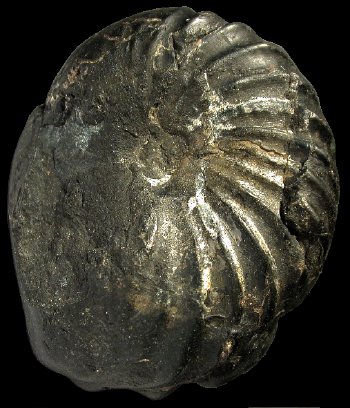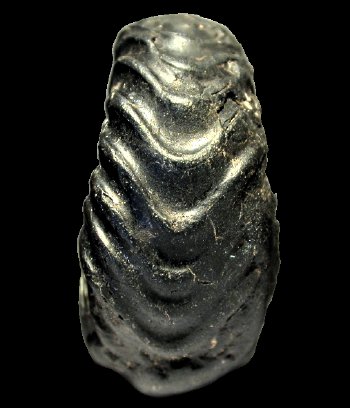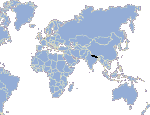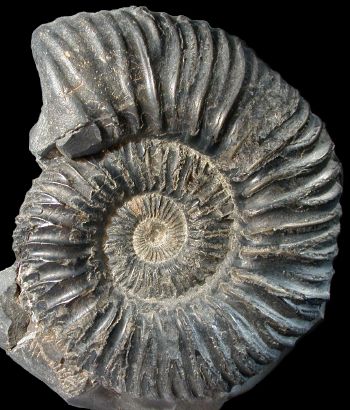




Haplophylloceras strigile (Blanford in Uhlig 1903) |
||
Haplophylloceras strigile (Blanford in Uhlig 1903)
Étage
Tithonien (-141 à -135 millions d'années) supérieur
Localité
Himalaya - Népal

Dimensions
Diamètre = 5,7 cm (2.24")
Epaisseur à l’ouverture = 2,9 cm (1.14")
Commentaire
Classification
Genre :
Haplophylloceras Spath 1925
Tithonien sup.
Spath (1925) pensait le genérotype issu de "Phylloceras" inordinatum (= Ptychophylloceras (Semisulcatoceras) ptychoicum inordinatum), auquel cas c’est un Ptychophylloceratinae. Mais cette ancienne conception est à considérer prudemment.
Tours internes lisses. Ventre rond, puis plat sur les tours externes où se développe une ornementation de forts plis proverses devenant tranchants à l’approche du ventre qu’ils traversent en se projetant très nettement et formant des chevrons. Ombilic infundibuliforme. Mur ombilical en pente douce. Sutures dont les selles tendent à perdre le caractère phylloïde et devenant multifides.
Sous-famille :
Ptychophylloceratinae Collignon 1956
Toarcien à Albien sup./?Cénomanien inf.
Famille :
Phylloceratidae Zittel 1884
Hettangien à Maastrichtien.
Formes involutes, lisses ou ornées de stries, costules ou côtes. Constrictions souvent présentes et falciformes ou sigmoïdes. La forme des sutures est un élément déterminant dans la phylogénèse. Ici, les selles sont à terminaisons phylloïdes diphylles (à deux phyllites), triphylles (à trois phyllites) ou tetraphylles (à 4 phyllites), très rarement hexaphylles (à sixphyllites) ou octophylles (à huit phyllites). [d’après Joly].
Super-famille :
Phylloceratoidea Zittel 1884
Sous-ordre :
Phylloceratina Arkell 1950
Ordre :
Ammonoidea Zittel 1884
Classe :
Cephalopoda Cuvier 1797
Embranchement :
Mollusca Linnaeus 1758
Super-embranchement :
Bilateria: Protostomia Hatschek, 1888: Grobben 1908
Sous-règne :
Eumetazoa Butschli 1910
Règne :
Animalia Linnaeus 1758
Super-règne :
Eukaryota Whittaker & Margulis 1978
Documents
2020. Howarth, M., K.
Part L, Revised, Volume 3B, Chapter 2: Systematic Descriptions of the Jurassic and Cretaceous Phylloceratoidea, Boreophylloceratoidea, and Aequiloboidea
in Treatise Online - Nb 128 - Paleontological Institute, University of Kansas
p 17, fig 16a-c (=Haplophylloceras strigile (BLANFORD), a holotype) - lien
1997. Énay, R. & Cariou, E.
Ammonite faunas and palaeobiogeography of the Himalayan belt: Initiation of a Late Jurassic austral ammonite fauna
in Palaeo (Palaeogeography, Palaeoclimatology, Palaeoecology) - 134 (1997) - Elsevier Science Ltd.
p 15
1996. Énay, R. & Cariou, E.
Biostratigraphy of the Spiti shales formation of the Thakkhola, Central Nepal - 4th International Symposium Cephalopods - Granada 15-17 july 1996
p 1
1993. Sukamto, R. & Westermann, G., E., G.
Indonesia and Papua New Guinea
in Westermann, G., E., G. - The Jurassic of the Circum-Pacific - Ch 8 - Cambridge University Press
p 183, pl 86
1979. Thomson, M., R., A.
Upper Jurassic and Lower Cretaceous Ammonite Faunas of the Ablation Point Area, Alexander Island
in British Antarctic Survey Scientific Reports - No. 97 - British Antarctic Survey - Natural Environment Research Council
p 8, pl II
1957. Arkell, W., J., Furnish, W., M., Kummel, B., Miller, A., K., Moore, R., C., Schindewolf, O., H., Sylvester-Bradley, P., C. & Wright, C., W.
Treatise on Invertebrate Paleontology. Part L. Mollusca 4. Ammonoidea.
Raymond C. Moore - Geological Society of America
p 189, pl 533
1938. Roman, F.
Les Ammonites jurassiques et crétacées
Masson
p 19, pl II
Contenu révisé le 3 mars 2024 - Fiche générée le 3 mars 2024 - 1ère publication le 30 août 2004


Espèce type du genre de Spath. Elle fait partie des rares taxons (avec Corongoceras et Proniceras) associés à Blanfordiceras dans l’horizon du même nom au sommet de la formation des Spiti Shales (Himalaya).